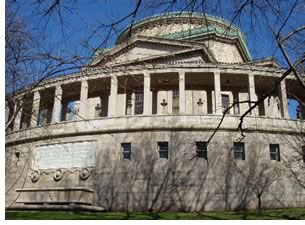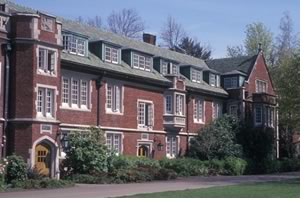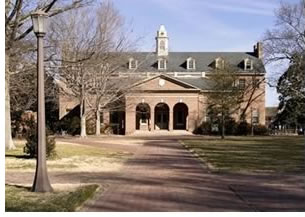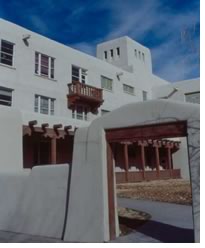

10/2004
Awards to be used for historic preservation
 The
Getty Grant Program announced earlier this year the recipients of the
2004 Campus Heritage Grants. The beneficiaries of the awards include
buildings in a range of styles, from the Beaux-Arts tradition of
Morehouse College in Atlanta to the Romanesque, Italianate, and Neoclassical
academic buildings of the University of Maine in Orono. Bronx Community
College, New York City, is the recipient of this year’s largest
grant, and will use the funds for a conservation master plan for its
original campus designed by McKim, Mead & White.
The
Getty Grant Program announced earlier this year the recipients of the
2004 Campus Heritage Grants. The beneficiaries of the awards include
buildings in a range of styles, from the Beaux-Arts tradition of
Morehouse College in Atlanta to the Romanesque, Italianate, and Neoclassical
academic buildings of the University of Maine in Orono. Bronx Community
College, New York City, is the recipient of this year’s largest
grant, and will use the funds for a conservation master plan for its
original campus designed by McKim, Mead & White.
 “Since
a large portion of this nation’s distinguished architectural
heritage is found on college and university campuses, it is extremely
important to incorporate historic preservation into the campus master
planning processes,” says Deborah Marrow, director of the Getty
Grant Program and dean for external relations of the J. Paul Getty Trust. “Designed
by major architects of the day, some are built on archaeologically or
historically important sites,” Getty officials note. In the case
of Bronx Community College, the money will be used for research and analysis
of the campus buildings, including Gould Memorial Library, which is modeled
on the Pantheon in Rome. The buildings are clad in a distinctive yellow
Roman brick trimmed with limestone and terra cotta and boast elaborate
interiors but are battling damage from water infiltration, failure of
materials, and highway and industrial pollution.
“Since
a large portion of this nation’s distinguished architectural
heritage is found on college and university campuses, it is extremely
important to incorporate historic preservation into the campus master
planning processes,” says Deborah Marrow, director of the Getty
Grant Program and dean for external relations of the J. Paul Getty Trust. “Designed
by major architects of the day, some are built on archaeologically or
historically important sites,” Getty officials note. In the case
of Bronx Community College, the money will be used for research and analysis
of the campus buildings, including Gould Memorial Library, which is modeled
on the Pantheon in Rome. The buildings are clad in a distinctive yellow
Roman brick trimmed with limestone and terra cotta and boast elaborate
interiors but are battling damage from water infiltration, failure of
materials, and highway and industrial pollution.
Getty grants will also fund studies that will preserve the work of architects such as Charles Klauder, who left his mark at Princeton and Yale and also was responsible for buildings at Rhodes College, Memphis, and the University of Pittsburgh, where his soaring 42-story Gothic Revival Cathedral of Learning is one of the tallest campus buildings in the world. At Bucknell University, Lewisburg, Pa., grant funds will support the development of a preservation plan for the core campus, which includes buildings by Thomas U. Walter, architect for the wings and dome of the U.S. Capitol
 Campus
Heritage Grants also will guide the preservation of landscape design
at several institutions, including the 107-acre campus of Lake Forest
College, Lake Forest, Ill., designed by the pioneer landscape gardener
Almerin Hotchkiss to take advantage of the site’s ravines
and lakeside bluffs, and the grounds of Reed College, Portland, Ore.,
situated on the scenic former Crystal Springs dairy farm, and planted
with more than 1,000 trees representing more than 100 different species.
At the University of Arizona in Tucson funds will help officials survey
the historic district of the 490-acre campus that includes 500 species
of local flora and arid-land plants from around the world, several of
which are unique to the Southwest. Cranbrook Educational Community, Bloomfield
Hills, Mich., is using a Getty grant to prepare a conservation plan for
its formal gardens and natural woods, lakes, and waterways.
Campus
Heritage Grants also will guide the preservation of landscape design
at several institutions, including the 107-acre campus of Lake Forest
College, Lake Forest, Ill., designed by the pioneer landscape gardener
Almerin Hotchkiss to take advantage of the site’s ravines
and lakeside bluffs, and the grounds of Reed College, Portland, Ore.,
situated on the scenic former Crystal Springs dairy farm, and planted
with more than 1,000 trees representing more than 100 different species.
At the University of Arizona in Tucson funds will help officials survey
the historic district of the 490-acre campus that includes 500 species
of local flora and arid-land plants from around the world, several of
which are unique to the Southwest. Cranbrook Educational Community, Bloomfield
Hills, Mich., is using a Getty grant to prepare a conservation plan for
its formal gardens and natural woods, lakes, and waterways.
 Archaeologically
important or historic sites are the focus of grants at Middlebury College,
Middlebury, Vt., a showcase of collegiate architecture featuring buildings
in the Gothic Revival, Beaux-Arts, and Georgian styles, and the University
of California, Santa Cruz, which was built on a 19th-century ranch complete
with barns, a granary, blacksmith’s shop, and cookhouse. The campus
is also situated in a region with evidence of prehistoric Native American
Ohlone settlements. The University of the South, Sewanee, Tenn., contains
distinctive Oxford-style buildings of native sandstone built after the
Civil War as well as important archaeological sites from the earliest
historic settlements on the Cumberland Plateau. University of the South
will use grant funds to prepare an up-to-date inventory and assessment
of these architectural and cultural resources for a multiple-resource
nomination to the National Register of Historic Places.
Archaeologically
important or historic sites are the focus of grants at Middlebury College,
Middlebury, Vt., a showcase of collegiate architecture featuring buildings
in the Gothic Revival, Beaux-Arts, and Georgian styles, and the University
of California, Santa Cruz, which was built on a 19th-century ranch complete
with barns, a granary, blacksmith’s shop, and cookhouse. The campus
is also situated in a region with evidence of prehistoric Native American
Ohlone settlements. The University of the South, Sewanee, Tenn., contains
distinctive Oxford-style buildings of native sandstone built after the
Civil War as well as important archaeological sites from the earliest
historic settlements on the Cumberland Plateau. University of the South
will use grant funds to prepare an up-to-date inventory and assessment
of these architectural and cultural resources for a multiple-resource
nomination to the National Register of Historic Places.
Copyright 2004 The American Institute of Architects.
All rights reserved. Home Page ![]()
![]()
 |
||
Click here
to see a list (PDF) of Campus Heritage Grant Recipients.
|
||